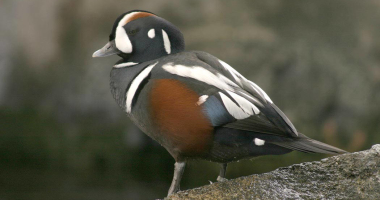Grants Support Bird Research

One way Montana Audubon conducts its outreach and research, is to award small grants to wildlife projects that other individuals are spearheading. Our grants are awarded through the Audubon Wildlife Fund of Montana, a permanent endowment. We’ve given out grants for the last 21 years, supporting research and education projects directed toward wildlife and/or wildlife habitat.
Our 2016s grants include:
Monitoring Nocturnal Migrating Birds in the Bitterroot Valley. In an effort to understand where and when our birds migrate, the MPG Ranch in the Bitterroot Valley is teaming up  with high schools in Florence and Darby. Recorders placed in key locations will pick up bird calls during the night. The sites will record migrants’ calls in the spring and fall of 2016. Participating students are trained to maintain the equipment, use ‘open-source’ software to extract the bird calls, classify the calls to species, and look for patterns in the data. This technology can detect little-known or secretive species in the Bitterroot Valley; units deployed on MPG Ranch have recorded Barn Owl, Upland Sandpiper, Virginia Rail, and Sora (see picture right). Over multiple years, the information has the potential to track population trends and migration pathways. Long-term, this project may lead to a network of acoustic bird monitors located throughout the Bitterroot Valley—and possibly throughout Montana.
with high schools in Florence and Darby. Recorders placed in key locations will pick up bird calls during the night. The sites will record migrants’ calls in the spring and fall of 2016. Participating students are trained to maintain the equipment, use ‘open-source’ software to extract the bird calls, classify the calls to species, and look for patterns in the data. This technology can detect little-known or secretive species in the Bitterroot Valley; units deployed on MPG Ranch have recorded Barn Owl, Upland Sandpiper, Virginia Rail, and Sora (see picture right). Over multiple years, the information has the potential to track population trends and migration pathways. Long-term, this project may lead to a network of acoustic bird monitors located throughout the Bitterroot Valley—and possibly throughout Montana.
Supporting Students at Salish Kootenai College in Pablo. Montana Audubon’s grant will

primarily cover mileage for wildlife education and research, including:
- Providing opportunities for students to interact with professionals beyond SKC faculty by attending professional meetings and additional field trips;
- Securing guest presentations from professionals studying and managing nongame wildlife and their habitats. These presentations will be open to the greater community to attend, available to watch on KSKC-TV, and filmed so that they are available at the SKC Library.
- Continuing student research and citizen science surveys of Long-billed Curlews, waterbirds, macroinvertebrates, and wetland habitats; and
- Purchasing a subscription of the Cornell Lab of Ornithology’s online Birds of North America to aid with both education and research activities.
Researching Harlequin Duck Migration and Connectivity .
.
Glacier National Park and other entities are working to understand more about our Harlequin Ducks, including how they use their Montana habitat and the timing of their migration to and from the Pacific Coast. This project is part of an international study. For Montana’s part, six Harlequins will be fitted with transmitters and followed for two to three years. Ultimately, we’ll all learn more about Harlequin Ducks and how to manage them. The specific questions researches hope to find answers to surround breeding-season habitat use, home-range characteristics (i.e. size, core area, distribution), site fidelity (do they come back to the same stream segment every year), adult and juvenile dispersal, and the timing of migration movements (i.e. inland movements, molt migration, wintering).
Click here for more information about the Audubon Wildlife Fund.